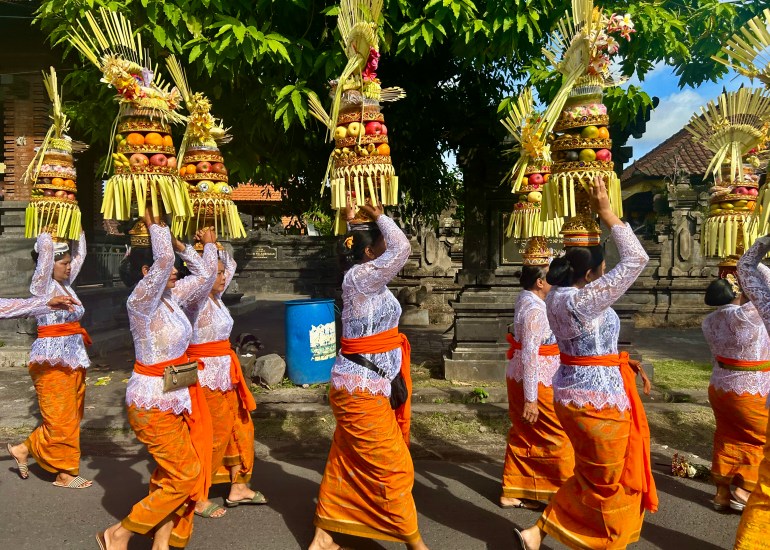Bali, Indonesia – At daybreak, as the primary shards of sunshine dance over the rice fields within the seaside village of Seseh on Bali’s west coast, Putu and her husband Made, who like many Indonesians go by one identify solely, spend an hour reciting prayers and distributing small palm leaf baskets containing choices to make sure the well being of the approaching harvest.
Later within the day, their 11-year-old daughter will attend a category for “sanghyang dedari”, a sacred trance dance for ladies that’s designed to counteract unfavorable supernatural forces.
In the meantime, her two older brothers will hone their abilities on picket xylophones and hand drums as a part of a conventional “gamelan” orchestra in preparation for a ceremony celebrating the completion of a brand new Hindu temple, one among greater than 10,000 on the island.
Within the coming weeks, Made and his youngsters will assist their neighbours create large “ogoh-ogoh” dolls, representations of evil mythological creatures common from wooden, bamboo, paper and styrofoam, that will probably be paraded via the streets and set alight the evening earlier than Nyepi, the Balinese Hindu new 12 months.
Going down this 12 months on March 11, Nyepi, or the “day of silence”, will see each mild on the island turned off, transport come to a halt and the airport shut. Everybody, Balinese or not, will keep at house to provide evil spirits the impression there’s nothing to be discovered on the island.
“Daily I lay choices, attend a ceremony or go to a temple,” Putu informed Al Jazeera. “I do that as a result of I’m Hindu, as a result of I consider. My youngsters do the identical and after they have youngsters, they’ll do the identical additionally.”
The Balinese anomaly
Putu’s hopes for the long run are shared with the overwhelming majority of Balinese, an island the place a hybrid Hindu-Buddhist faith primarily based on ancestor worship and animism relationship again to the primary century has survived and even thrived within the face of mass tourism.
By 1930, vacationer numbers reached a number of hundred per 12 months. Final 12 months, 5.2 million foreigners together with 9.4 million home holidaymakers visited Bali, in line with authorities information, and the island is growing at breakneck pace to cater to the demand.
The unfavorable results of such large development are illustrated within the murals of Balinese artist Slinat, who marries the enduring images of Balinese dancers with up to date emblems like fuel masks and greenback payments.
“These outdated images had been the primary pictures used to advertise tourism in Bali and convey that it’s an unique place. They kick-started tourism in Bali,” Slinat informed Al Jazeera. “However then we had an excessive amount of tourism and it ruined the exoticness of Bali. So I created this parody to specific how a lot issues have modified right here since these images had been taken.”
However, Balinese conventional tradition and faith have remained resilient within the face of the vacationer onslaught, which is one thing of an anomaly in contrast with different vacationer sizzling spots world wide.
“When native folks entertain vacationers, they adapt [to] vacationers’ wants, attitudes and values and in the end begin to comply with them. By following vacationers’ way of life, younger folks deliver modifications within the materials items,” was the discovering of a examine on the influence of tourism on tradition that was revealed in 2016 within the Journal of Tourism, Hospitality and Sports activities.
The examine mentioned the Pokhara-Ghandruk neighborhood in Nepal was a textbook instance, the place “the standard vogue, behaviour and way of life of younger Gurungs have been severely affected by tourism … [who] disobey their elders’ Kinship titles”. It mentioned Indonesia was an exception – a rustic the place “to draw distant vacationers, youngsters nurture native customs to create a powerful and genuine base of cultural elements with out disrupting ancestors’ values”.

A lecturer in conventional structure at Warmadewa College in Bali, I Nyoman Gede Maha Putra explains the roots of that method.
“Colonial authorities insurance policies relationship again to the Thirties that promote how the Balinese needs to be Balinese, together with college curriculums, manufacturing of conventional meals and drinks and unsparing investments in non secular buildings have performed a key position in preserving tradition and faith on the so-called Island of the Gods,” he mentioned, including that building codes formalised within the Seventies that required no new constructing to be no taller than a coconut tree had helped keep “a way of the place” on the island.
“Quickly, all our younger folks will begin making ogoh-ogoh paper statues for Nyepi. Nobody will probably be ignored. They may benefit from the course of, they’ll benefit from the parades, and really feel proud when the vacationers see what they’ve made. And our day by day ceremonies will proceed as a result of we consider very strongly that our ancestors’ ghosts stay round us and our ceremonies are the one manner we are able to talk with them,” Maha Putra mentioned.
A facade
Others say it’s the adaptability of Balinese tradition that has made it resilient.
“Balinese tradition will not be static,” I Ketut Putra Erawan, a lecturer in political science at Bali’s Udayana College, informed Al Jazeera. “Time and time once more it has proven it has the ability to reinvent itself via the issues and alternatives we face; issues like tourism, social media, individualism, capitalism and mass tradition. It finds new methods to make itself related to younger folks in new instances.”
However these new shapes and expressions aren’t as stable as these of the previous, he cautions.
“At this time we’re flooded with a lot data and misinformation, and what that tends to do is promote the pores and skin of the tradition, the surface factor of the tradition, issues like consumerism and vogue, however not the core of the tradition,” Erawan mentioned. “Many individuals prioritise the fallacious issues of their cultural expressions. They’re much extra all for dressing like Balinese and telling everybody on social media they’re Balinese as a substitute of acquiring the excessive stage of information wanted to grasp our advanced tradition and faith.”
Rio Helmi, an Indonesian photographer whose work focuses on the interplay between Indigenous peoples and their atmosphere, agrees.
He fears time is working in opposition to Balinese tradition.
“As to the power of the tradition, I believe there’s some reality to that,” he informed Al Jazeera. “However quite a lot of it’s about id quite than involvement within the deeper facet of the tradition and its values. What I’m seeing now feels extra like kind over perform. Folks all the time repeat the phrase ‘tri hita karana’ – sustaining a great relationship between man and God, man and nature, man and the atmosphere – however typically it seems like a slogan, a bandage to cowl up dangerous issues like folks constructing on sacred land. We now have to watch out about making generalisations as there are nonetheless many individuals who stay historically. However the energy of cash is in every single place.”

At this time, multi-storey motels and condominiums many instances taller than coconut bushes are popping up throughout the island’s conventional rice fields. Nonetheless the largest show of the disparity between kind and performance, Helmi says, will probably be on show through the ogah-ogah procession in Ubud, the religious coronary heart of Bali that has expanded from a sleepy cultural village right into a bustling vacationer hotspot, the place there will probably be loudspeakers, memento distributors and bandstands.
“Will probably be an actual present placed on for vacationers, whereas within the villages the occasions will probably be about introspection, the sense of the 12 months coming to an finish and chasing the demons out. It’s their second, their tradition. It’s not a present,” Helmi mentioned.

